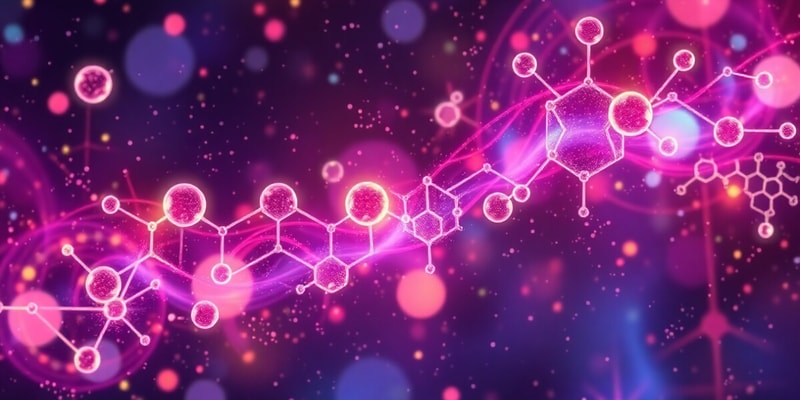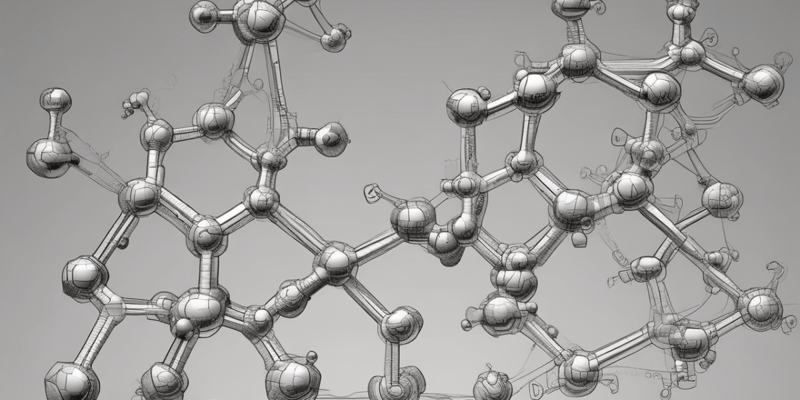Podcast Beta
Questions and Answers
What characteristic of the double bond in alkenes allows for the formation of cis and trans isomers?
Which of the following statements about cis-trans isomers is true?
Which of the following compounds is an example of a cis-trans isomer?
What is the function of the pheromone bombykol?
Signup and view all the answers
Which of the following is NOT a characteristic of ethene (ethylene)?
Signup and view all the answers
What is the IUPAC name for the compound with the structure CH3─C≡C─CH3?
Signup and view all the answers
In naming alkenes, if both double and triple bonds are present in a compound, how should the substituents be numbered?
Signup and view all the answers
What is the correct IUPAC name for the compound CH3─CH(CH3)─CH=CH─CH3?
Signup and view all the answers
Which of these is the correct old system naming for the compound HC≡C─C(CH3)─CH3?
Signup and view all the answers
What is the IUPAC name for a compound with two double bonds and the longest chain being six carbons long?
Signup and view all the answers
Which choice correctly identifies a compound that contains both double and triple bonds?
Signup and view all the answers
For the compound structure CH3─CH2─C≡C─C(CH3)2, what is the best IUPAC name?
Signup and view all the answers
What is the newer IUPAC name for the structure 4-methyl-2-pentene?
Signup and view all the answers
What is the IUPAC name for CH2═CH─CH2─CH3?
Signup and view all the answers
Which of the following correctly identifies the name for CH3─CH═CH─CH3?
Signup and view all the answers
What is the correct name for CH3─CH═C─CH3 with substituents?
Signup and view all the answers
How should carbon atoms be numbered in cycloalkenes to denote substituents?
Signup and view all the answers
What is the primary characteristic of the physical properties of alkynes?
Signup and view all the answers
Which of the following correctly describes a polymer?
Signup and view all the answers
What is one of the uses of alkynes in industrial synthesis?
Signup and view all the answers
What distinguishes cyclopropyne from typical cyclosubstituted compounds?
Signup and view all the answers
Which of the following compounds is commonly known as toluene?
Signup and view all the answers
What term is used to describe a benzene ring when it acts as a substituent?
Signup and view all the answers
In the context of disubstituted benzenes, which pair of substituents is in the ortho position?
Signup and view all the answers
Which of the following compounds represents nitrobenzene?
Signup and view all the answers
What is the significance of the Baeyer test in organic chemistry?
Signup and view all the answers
What does the term 'bromobenzene' refer to?
Signup and view all the answers
What requires consideration when naming benzenes with more than two substituents?
Signup and view all the answers
Which of the following describes a meta-disubstituted benzene arrangement?
Signup and view all the answers
What characterizes unsaturated hydrocarbons compared to saturated hydrocarbons?
Signup and view all the answers
Which of the following is the correct IUPAC naming for the alkene with the formula CH2=CH-CH2-CH3?
Signup and view all the answers
What is the general formula for alkenes?
Signup and view all the answers
What is the bond angle in a molecule containing a double bond according to VSEPR theory?
Signup and view all the answers
What effect does the presence of a double bond have on the shape of alkenes?
Signup and view all the answers
Which of the following correctly describes alkynes?
Signup and view all the answers
What is the common name for ethyne?
Signup and view all the answers
How do you identify the main carbon chain when naming an alkene?
Signup and view all the answers
Study Notes
Hydrocarbons
- Are organic compounds consisting only of carbon and hydrogen
- Can be saturated or unsaturated
- Saturated hydrocarbons have only single C-C bonds
- Unsaturated hydrocarbons contain double or triple C-C bonds
Alkenes and Alkynes
- Are unsaturated compounds
- Have fewer hydrogen atoms attached to the carbon chain than alkanes
- Alkenes contain double C=C bonds
- Alkynes contain triple C≡C bonds
Alkenes and Alkynes: Naming
- The names of alkenes are based on the corresponding alkane name, changing the ending from "-ane" to "-ene"
- The names of alkynes are based on the corresponding alkane name, changing the ending from "-ane" to "-yne"
- Numbering the carbon chain starts from the end nearer a double or triple bond.
Dienes and Trienes
- Alkenes containing more than one double bond
- The names of these compounds include "diene", "triene", etc. to indicate the number of double bonds.
Naming Alkenes and Alkynes with Substituents
- The IUPAC names for alkenes and alkynes with substituents need to specify the position of both the substituent and the double or triple bond.
Naming Cycloalkynes
- The names of cycloalkynes include the prefix "cyclo" followed by the alkane name and "-yne".
Physical Properties of Alkenes and Alkynes
- Alkenes and alkynes have low melting and boiling points.
- These points increase as the number of carbons increases.
- They are soluble in organic solvents but insoluble in water.
- The presence of the double or triple bond influences their reactivity.
Polymers
- are large, long-chain molecules
- are often found in nature, such as cellulose, proteins, and DNA
- are also made synthetically, such as polyethylene, Teflon, and nylon
- Consist of repeating monomers
Polymerization
- Monomers join to form polymers.
Ethene (Ethylene)
- Ethene, or ethylene, is the simplest alkene, C2H4.
- Has two carbon atoms connected by a double bond.
- Is flat and used to accelerate the ripening of fruits.
Cis-trans Isomers
- Cis–trans isomers are possible due to the rigidity and lack of rotation of the double bond.
- The prefixes "cis" and "trans" indicate the relative positions of substituents on the double bond.
Pheromones
- Are chemical messengers emitted by insects.
- Bombykol is an example with one cis and one trans double bond.
Aromatic Compounds
- Characteristic smell or aroma.
- Benzene is a common aromatic compound from coal distillate.
Naming Aromatic Compounds
- Rules for naming aromatic compounds include the use of prefixes like "ortho", "meta", and "para" for disubstituted benzene rings.
The Phenyl Group
- "Phenyl" refers to the benzene ring structure (C6H5 -) when it acts as a substituent.
- "Benzyl" refers to the group (C6H5CH2 -).
Baeyer Test for Unsaturation
- This test uses dilute potassium permanganate to oxidize double or triple bonds.
- The oxidation results in the replacement of the double or triple bond by a hydroxy group (an OH group).
Studying That Suits You
Use AI to generate personalized quizzes and flashcards to suit your learning preferences.
Related Documents
Description
This quiz covers the fundamental concepts of hydrocarbons, focusing on the differences between alkenes and alkynes. You'll learn how to name these unsaturated compounds and understand the significance of double and triple carbon bonds. Test your knowledge on the rules of IUPAC naming conventions and their application to these organic compounds.




